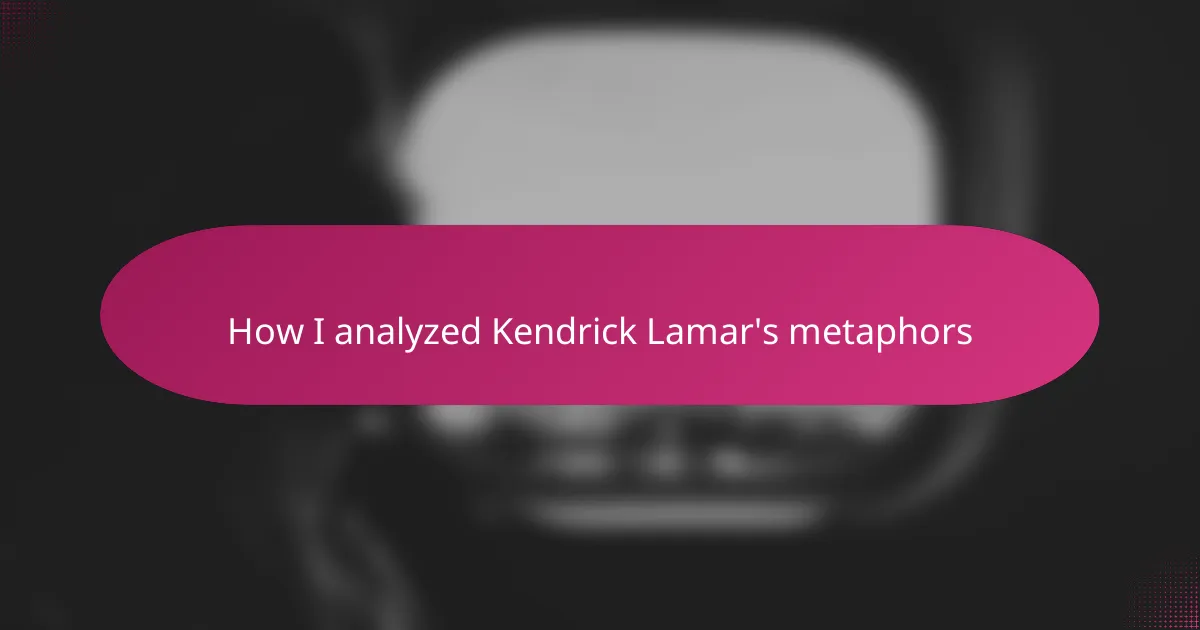Key takeaways
- Metaphors in rap, particularly by artists like Kendrick Lamar, serve as emotional bridges that connect personal struggles to broader societal issues.
- Understanding rap metaphors requires active listening, patience, and a willingness to explore deeper meanings and contextual elements.
- Analyzing lyrics step-by-step and utilizing resources like lyric annotations enhances comprehension and appreciation of complex metaphorical layers.
- Kendrick’s metaphors highlight the intersection of personal and social narratives, fostering empathy and deeper connections through music.
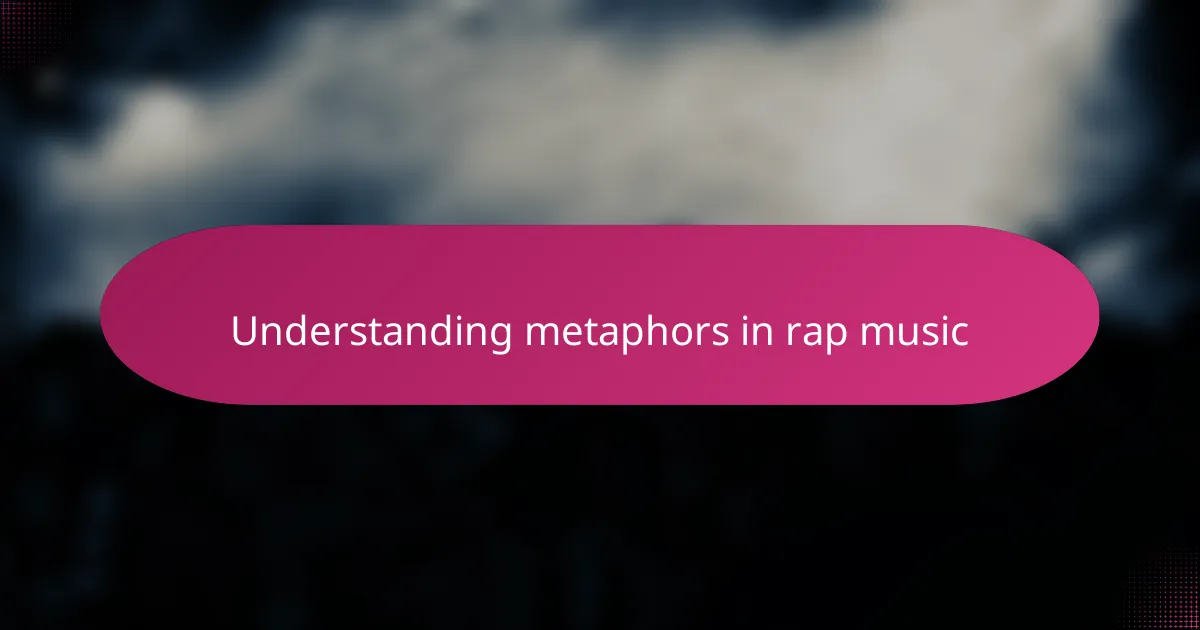
Understanding metaphors in rap music
Metaphors in rap music are like secret codes that reveal deeper layers of meaning beneath the surface. When I first started really paying attention, I found myself rewinding songs just to catch the clever connections artists make between personal struggles and broader social issues. Have you ever noticed how a single line can paint an entire story when you look beyond the literal words?
What fascinates me most is how these metaphors create an emotional bridge between the rapper and the listener. They’re not just poetic devices; they’re tools that transform pain, hope, and resilience into something almost tangible. I remember feeling this intensely when I heard a line that compared life’s battles to chess moves—it suddenly made the artist’s strategy and mindset so vivid and relatable.
Understanding metaphors in rap requires patience and a willingness to dig deeper, asking questions like: What is the artist really trying to say here? What emotions or experiences are they channeling? This process turned listening into an active, almost intimate experience for me, making each song feel like a personal conversation rather than just background noise.
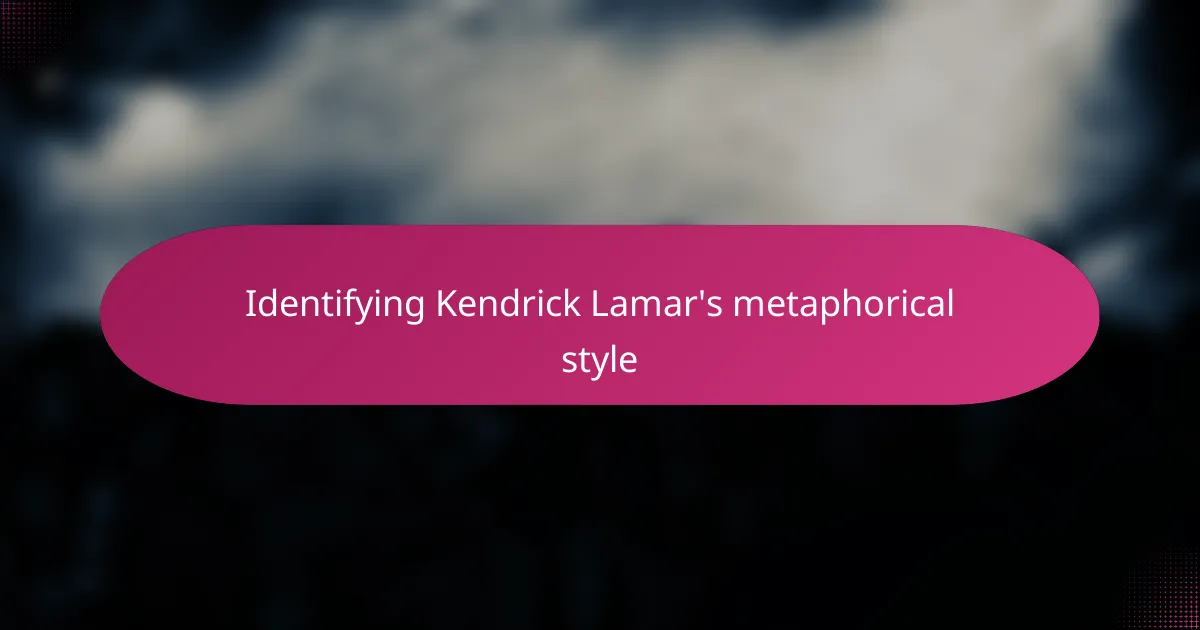
Identifying Kendrick Lamar’s metaphorical style
Kendrick Lamar’s metaphorical style struck me the first time I realized he wasn’t just telling stories—he was layering emotions, history, and culture into single lines. His metaphors often feel like puzzles, where each piece connects to social realities and personal truths. Have you ever felt a line from a Kendrick track hit deeper once you unraveled what it symbolized?
What sets Kendrick apart is his ability to weave metaphors that are both intensely personal and universally resonant. I found myself pausing repeatedly, wanting to trace how he shifted from a street-level image to a broader commentary on identity or survival. It’s this seamless blend that makes his metaphors feel alive, breathing complexity into every verse.
Listening to Kendrick, I’ve noticed how his metaphors often rely on vivid, almost cinematic imagery that invites you into his world. They aren’t just clever turns of phrase—they demand emotional investment, forcing you to see situations through his eyes. It’s like being handed a key to a deeper understanding, but first, you have to unlock the door yourself.
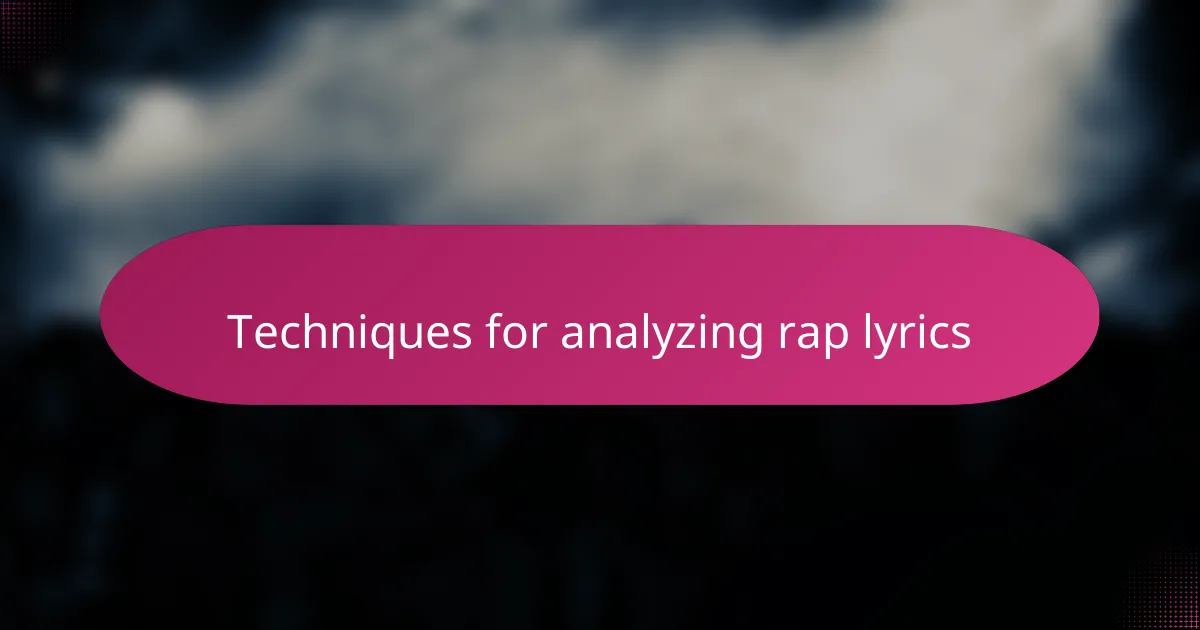
Techniques for analyzing rap lyrics
One technique I find invaluable is breaking down the lyrics line by line, almost like I’m dissecting a poem. When I do this, I ask myself: What is the literal meaning here, and what could be lurking beneath the surface? This method helps me catch subtle wordplay and hidden references that might otherwise slip past.
Another approach I rely on involves looking up cultural or historical references that Kendrick often weaves into his metaphors. At first, I underestimated how crucial context was, but once I dug into the background, the layers of meaning suddenly clicked into place. Have you ever felt that moment where a simple phrase transforms into a powerful statement once you understand its full context?
Sometimes, I listen to the track multiple times with different focuses—first for the story, then for the imagery, and finally for the emotions it evokes. This layered listening helps me connect emotionally and intellectually. It’s almost like piecing together a puzzle, where each rewind reveals a new insight or perspective.
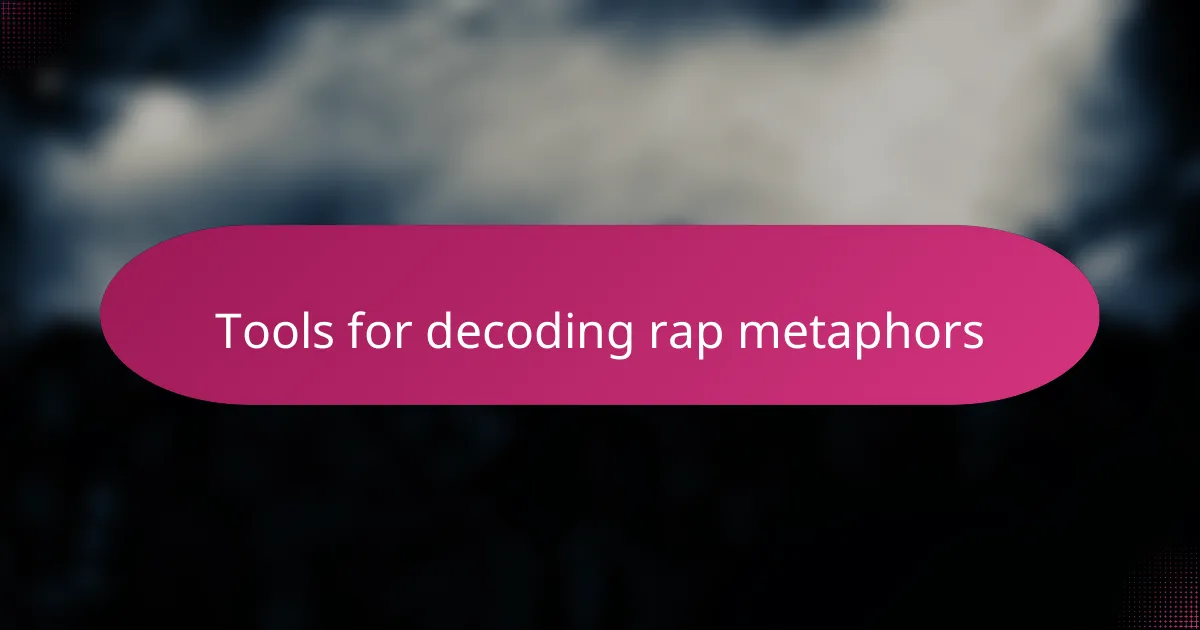
Tools for decoding rap metaphors
I often turn to online lyric annotations to help decode Kendrick’s complex metaphors. Sites like Genius provide community insights that sometimes spark those “aha” moments, helping me catch references I’d completely missed on my own. Have you ever stumbled on a line that felt indecipherable until someone else’s explanation suddenly made it crystal clear?
Another tool I swear by is keeping a mental or physical notebook where I jot down recurring symbols or phrases. Over time, patterns emerge—like how Kendrick uses water or chess imagery—which deepens my understanding and makes future listens richer. It’s fascinating how these symbols evolve across songs, creating a sort of metaphorical language unique to the artist.
I also rely heavily on contextual research—reading interviews, articles, or watching documentaries about Kendrick and his environment. This background isn’t just trivia; it’s the lens that colors his metaphors with real-world meaning. Without it, a metaphor might just seem clever, but with context, it becomes a powerful story that resonates on so many levels.
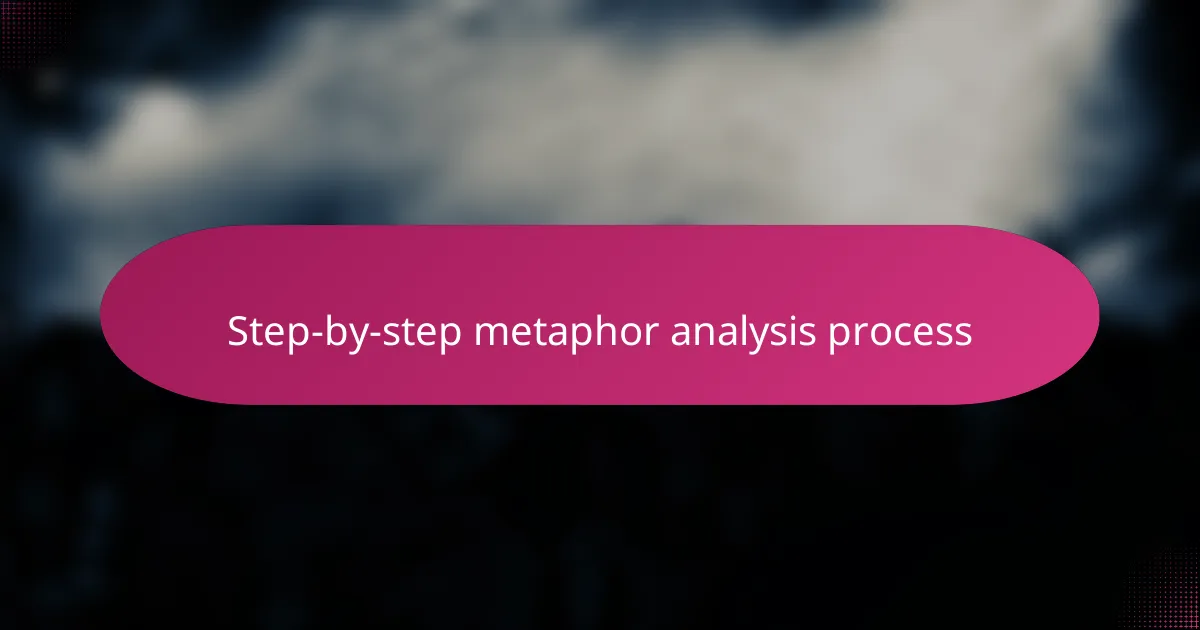
Step-by-step metaphor analysis process
When I analyze Kendrick Lamar’s metaphors step-by-step, I start by isolating each line that feels loaded with meaning. I ask myself, “What’s the surface idea here, and what deeper message could be hiding?” It’s like peeling an onion—each layer reveals more complexity and emotion.
Next, I usually sketch out the metaphor’s components—characters, objects, or settings—and consider how they relate to Kendrick’s broader themes. For example, if he’s comparing life to a battlefield, what specific battles does he mean? This breakdown helps me see how his personal stories connect to social issues, which always makes the metaphor hit harder.
Sometimes, I catch myself getting lost in the imagery, so I pause and reflect: “How does this metaphor make me feel? What’s the mood or atmosphere it’s creating?” These emotional insights guide me toward the heart of Kendrick’s message, turning an intellectual exercise into a more intimate experience with the music.
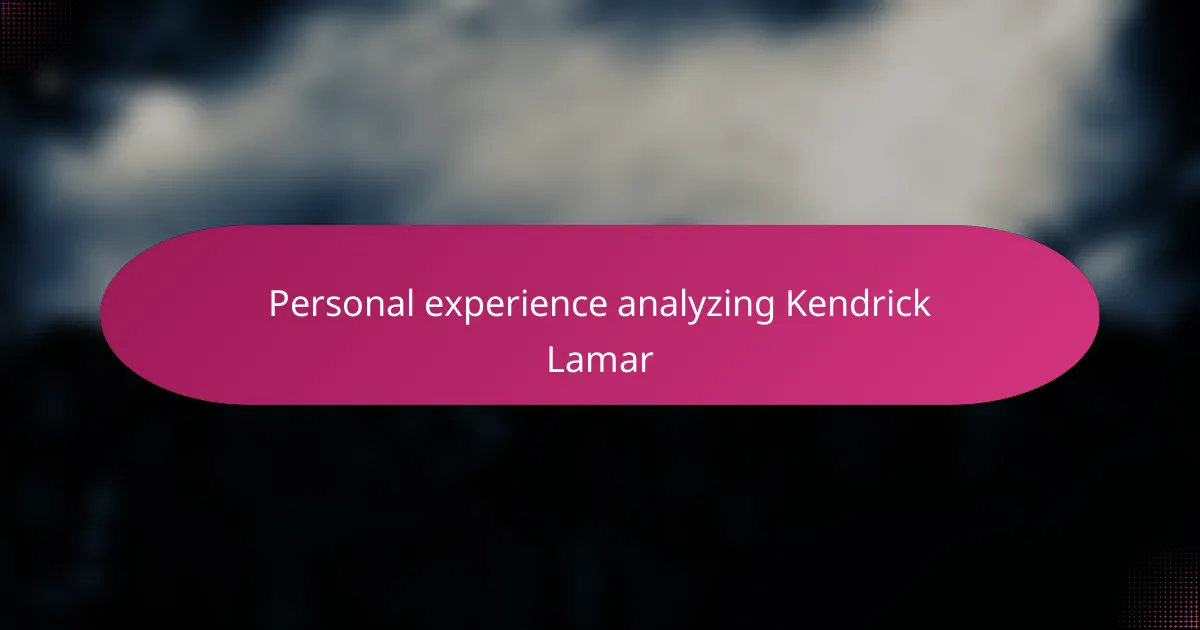
Personal experience analyzing Kendrick Lamar
Diving into Kendrick Lamar’s metaphors has been like unlocking a whole new layer of emotional depth in rap for me. I remember sitting alone with my headphones on, tracing his words over and over until those hidden meanings finally clicked—it felt like decoding a language only he spoke. Have you ever had that moment when a lyric suddenly hits you so hard you need to pause and just absorb it?
One time, I found myself staring at a particular metaphor for days, trying to untangle its layers. It wasn’t just about the cleverness—it stirred something personal, reminding me of my own struggles in ways I hadn’t expected. That experience taught me how Kendrick’s metaphors don’t just tell stories; they reach into your own life and reflect pieces of it back.
Sometimes, the process feels almost meditative. I ask myself, “What feelings is he really trying to paint here?” and let the imagery settle in. Analyzing Kendrick’s metaphors isn’t just an intellectual puzzle; it’s an emotional journey that deepens my connection to his music every single time.
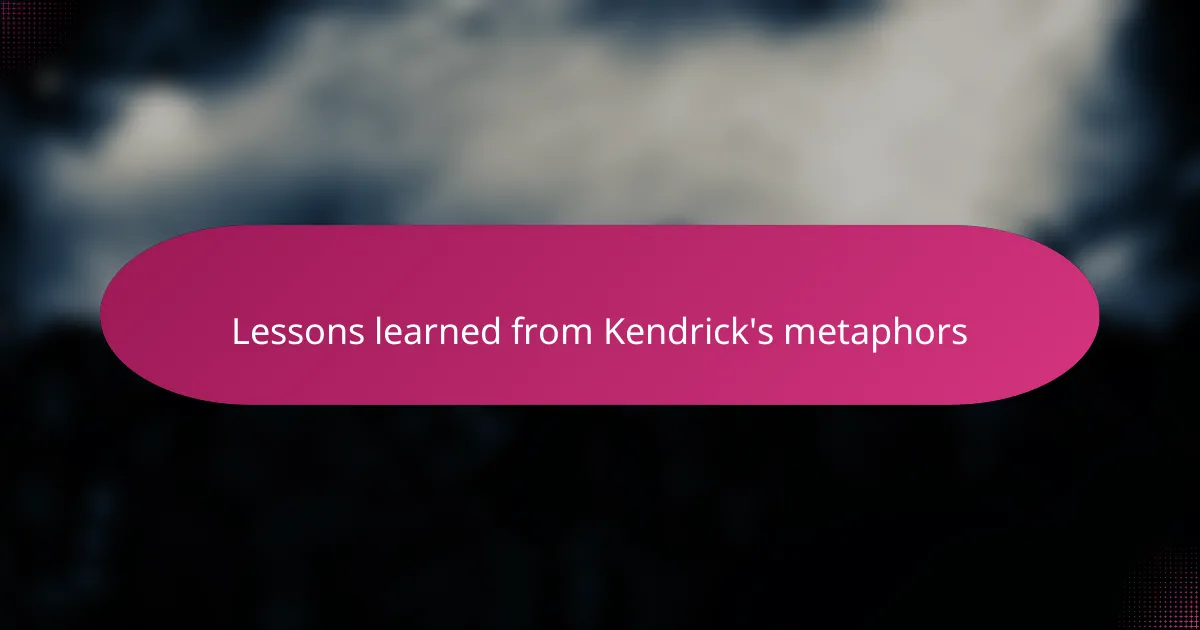
Lessons learned from Kendrick’s metaphors
What really struck me from analyzing Kendrick’s metaphors is how they taught me to listen with intention, not just hear. Have you ever realized that a single metaphor can carry the weight of entire life experiences, shifting your perspective in an instant? Kendrick’s skill reminds me that metaphors aren’t just decorative—they’re vehicles for empathy and understanding.
Another lesson I picked up is how patience is key. When I first tried to unpack his layered imagery, I felt overwhelmed, but sticking with it revealed nuances about community, identity, and resilience that I hadn’t anticipated. It’s fascinating how patience turns what seems complex into something deeply human and relatable.
Lastly, Kendrick’s metaphors showed me the power of connection—how personal struggles and broader social issues can coexist in a single line. This taught me that a great metaphor doesn’t just communicate—it invites you to remember your own story within his. Have you noticed how that makes listening feel less like a performance and more like a conversation?
